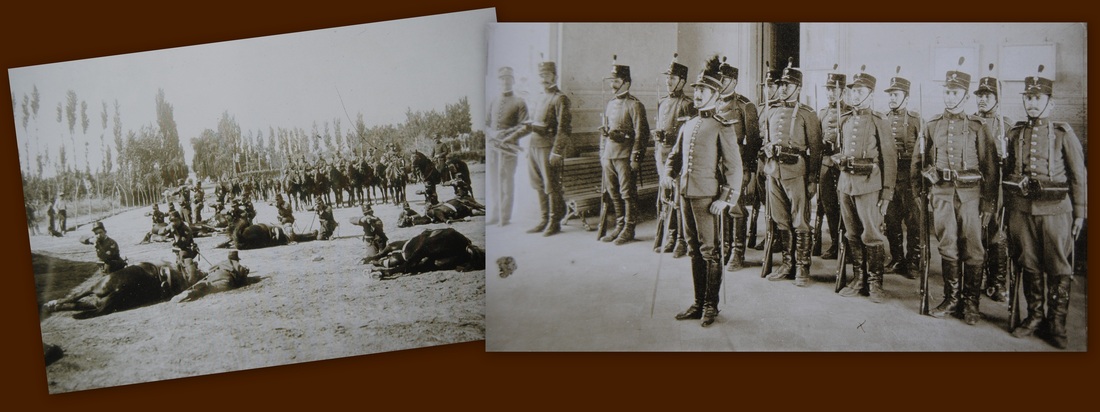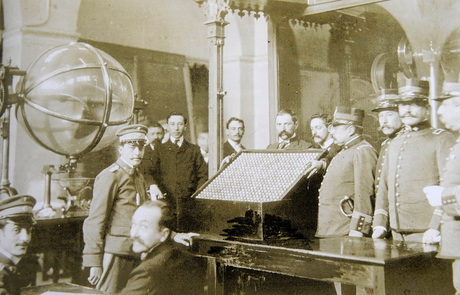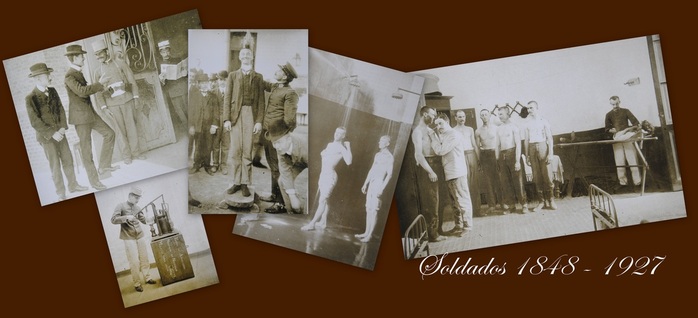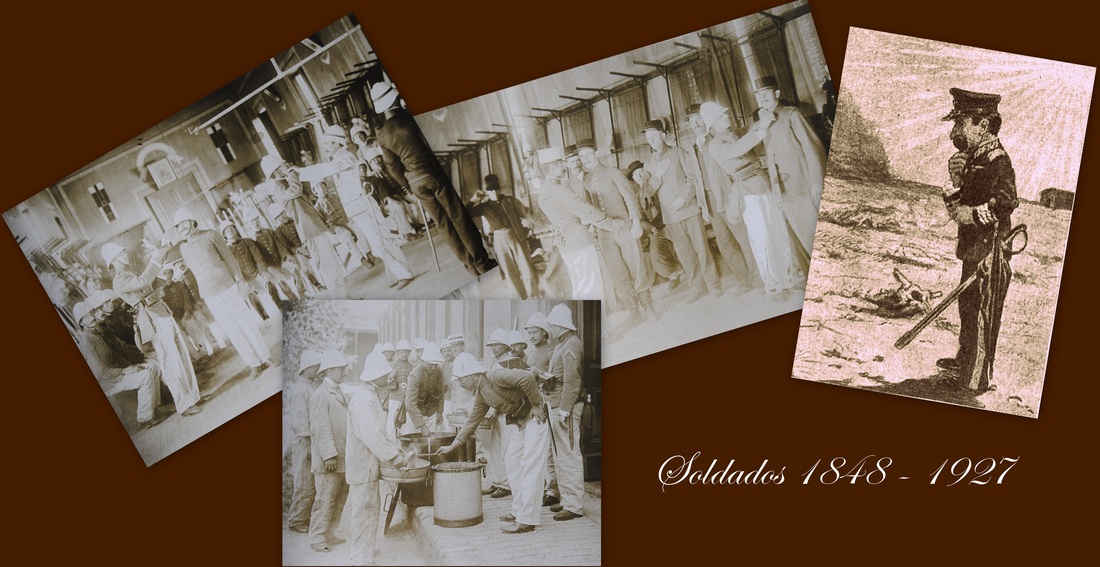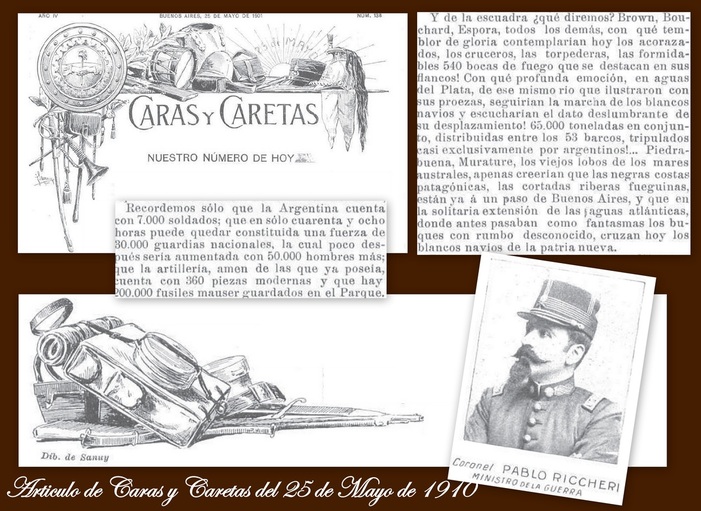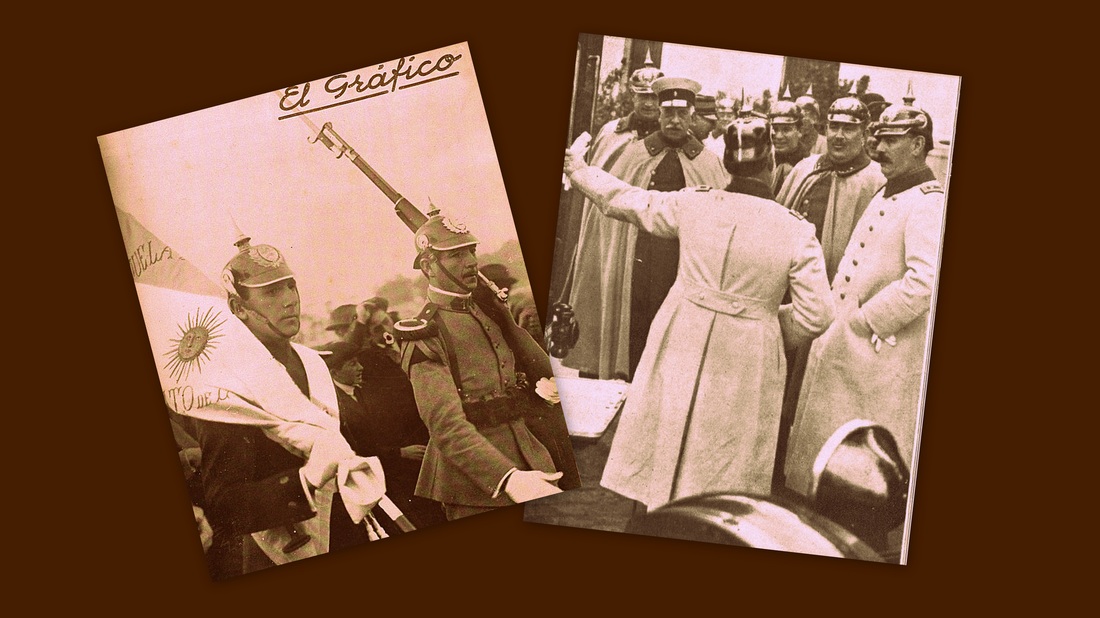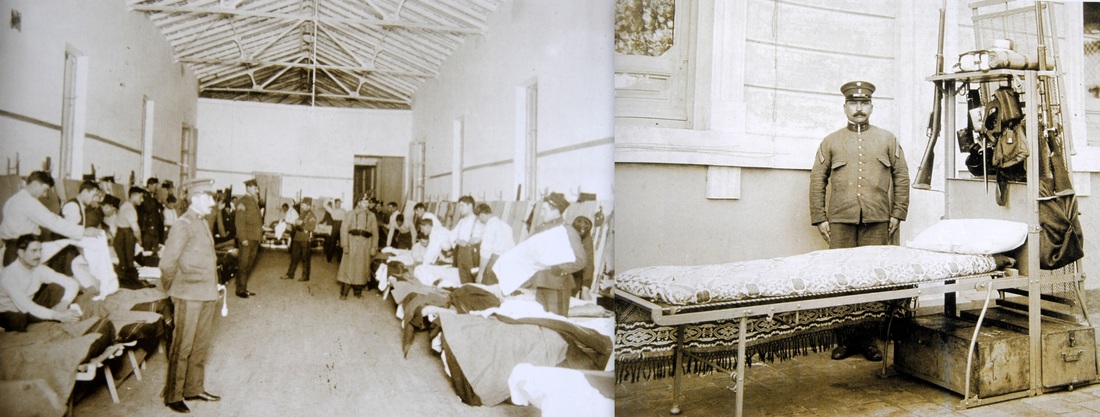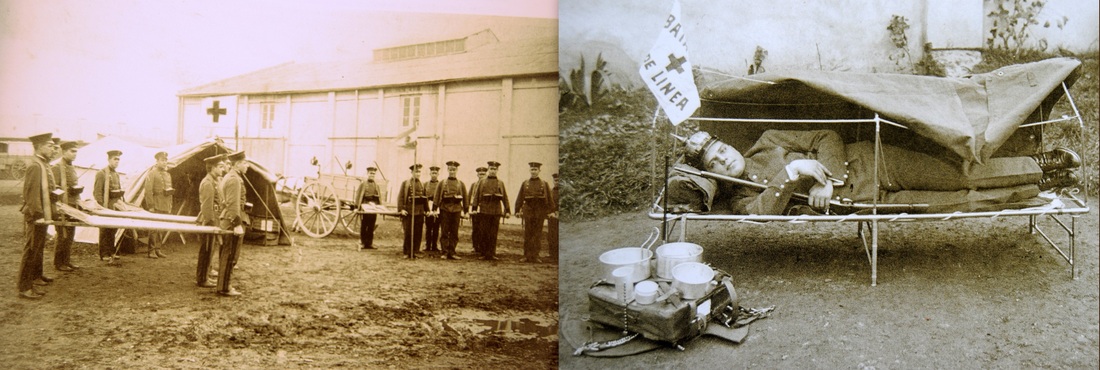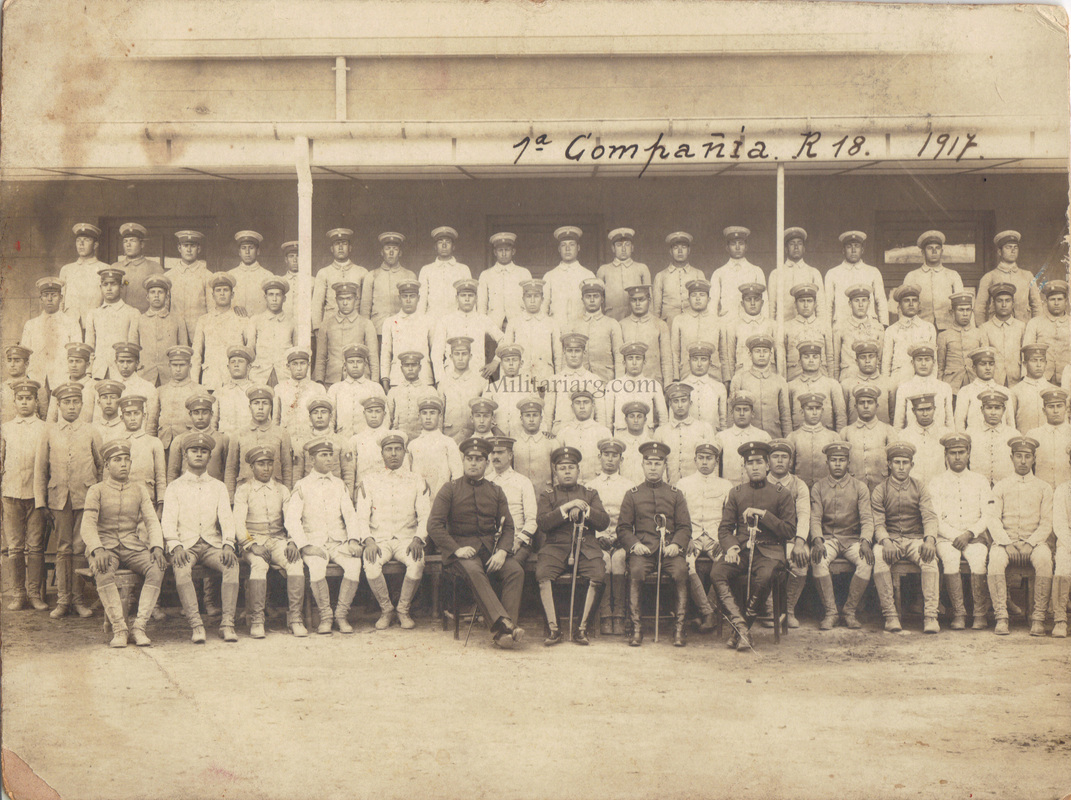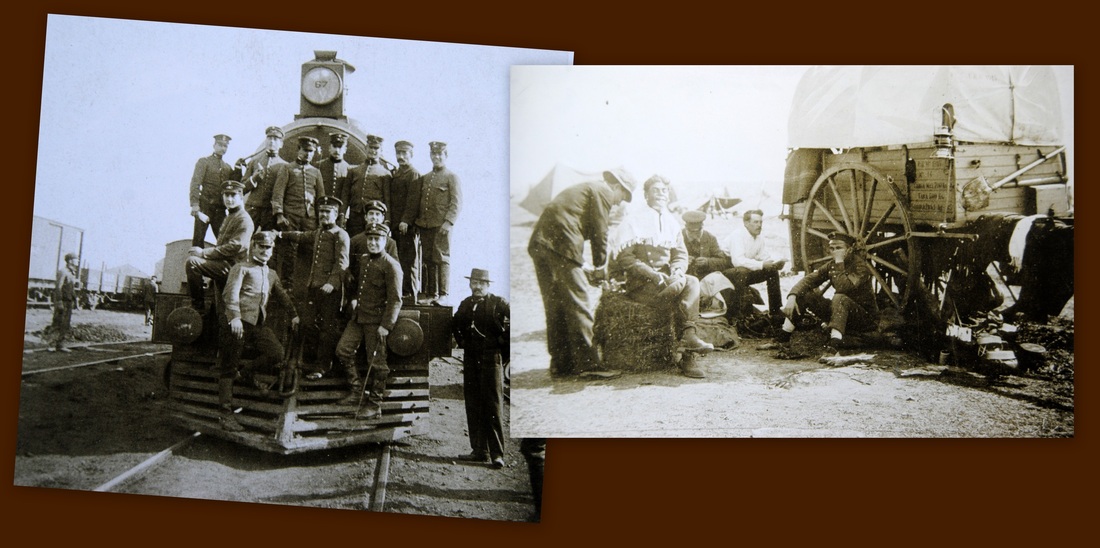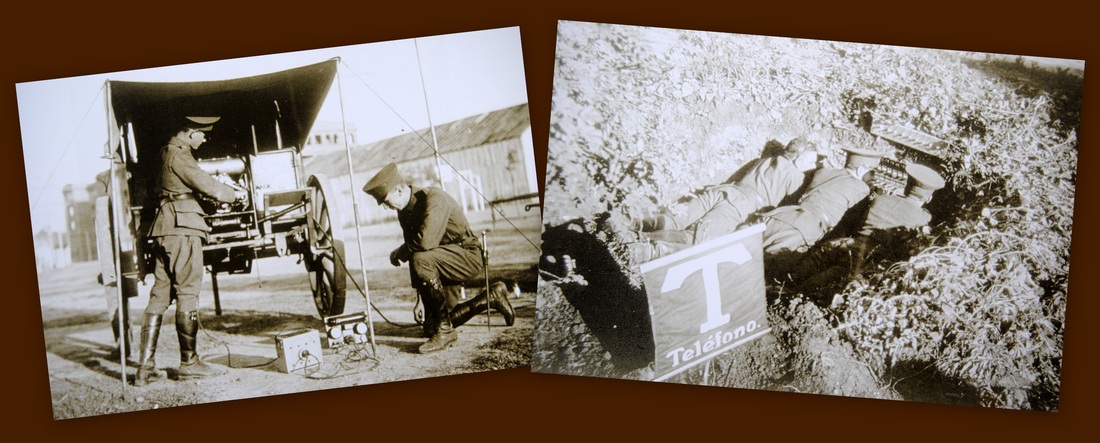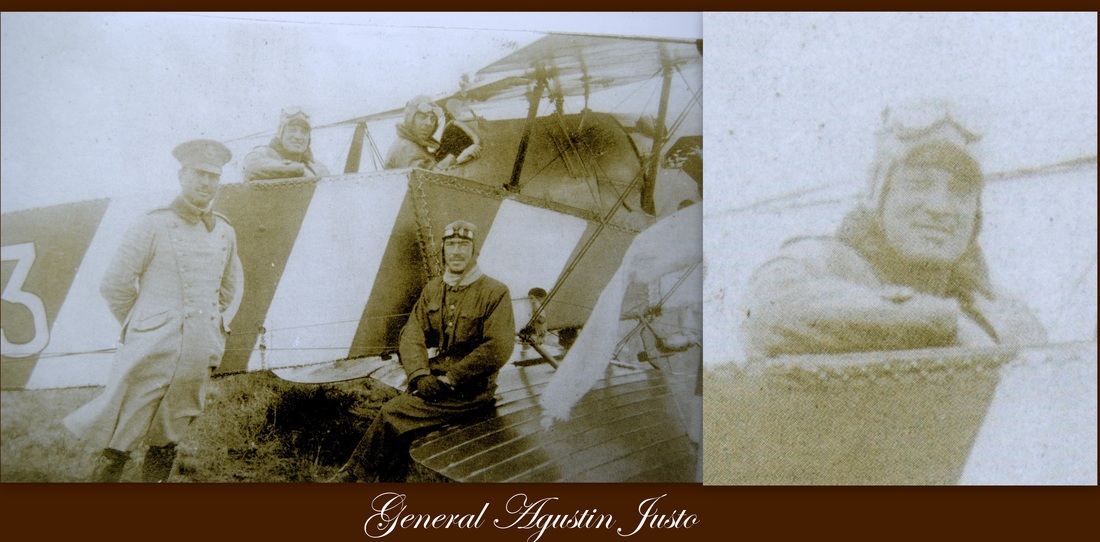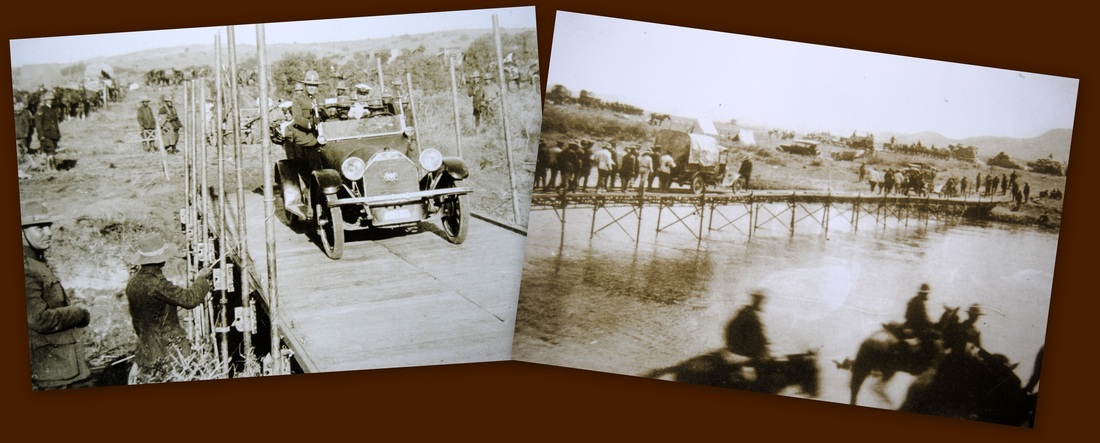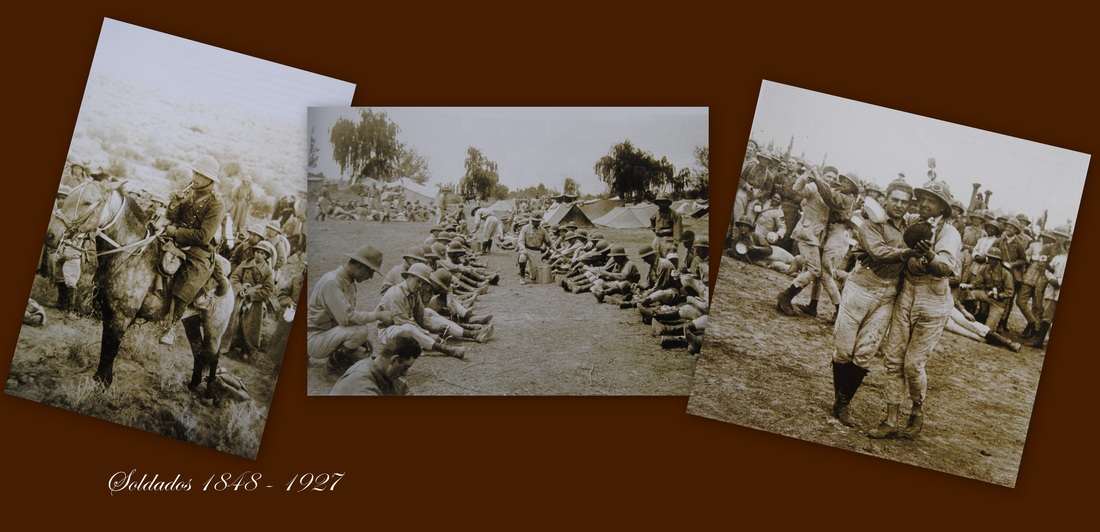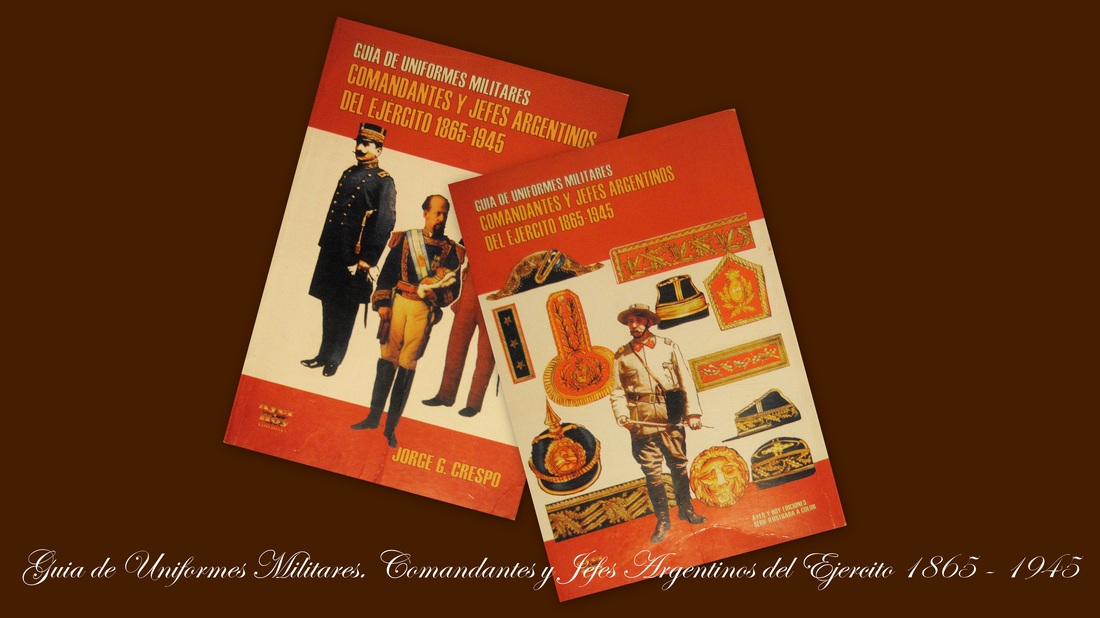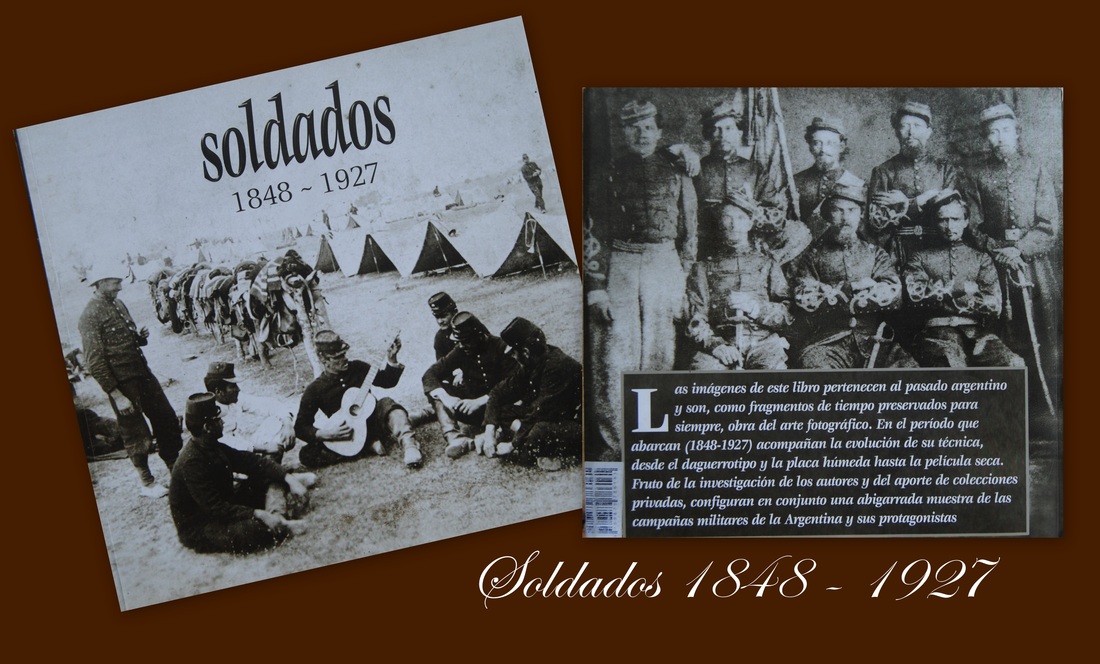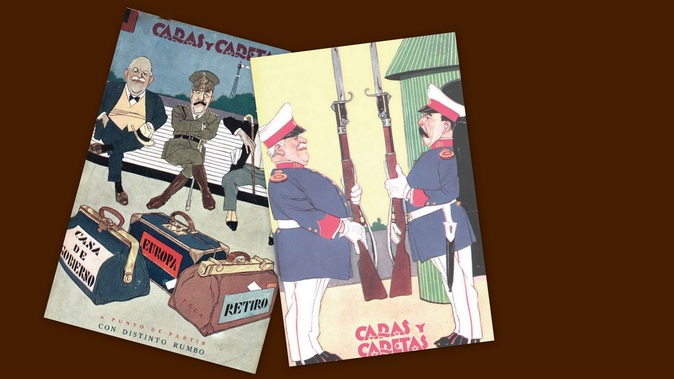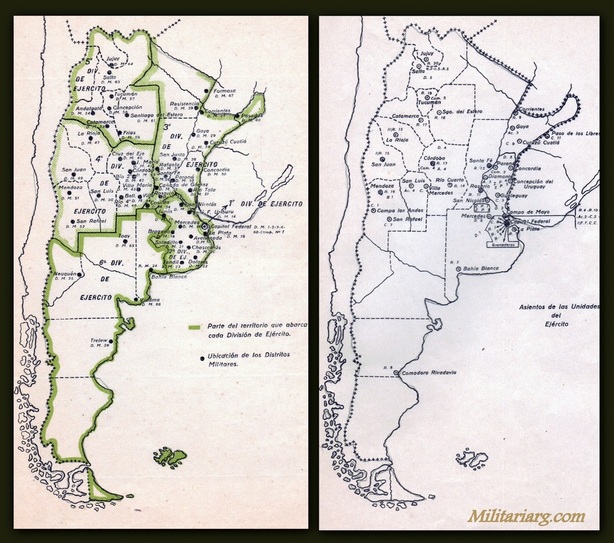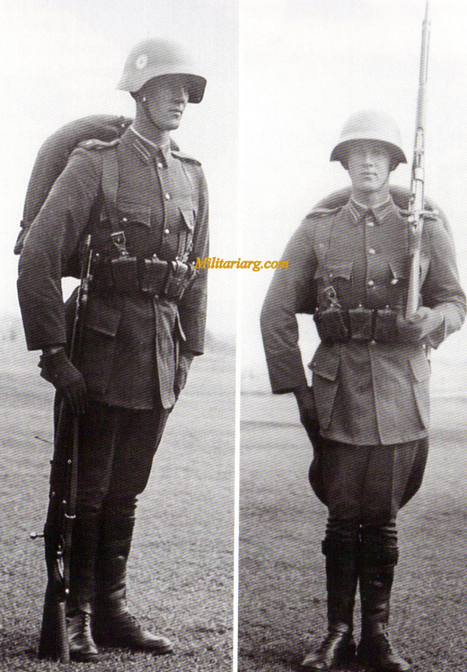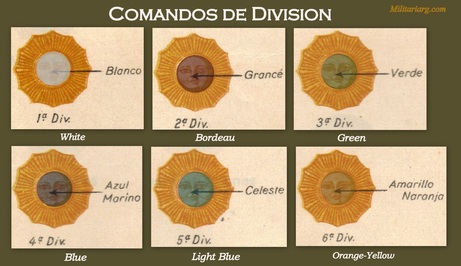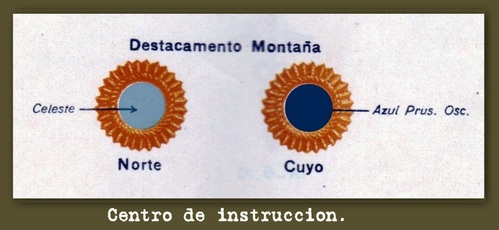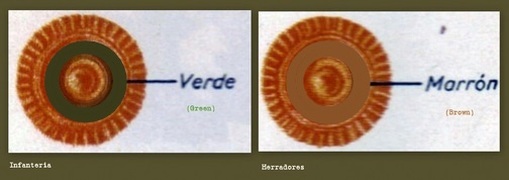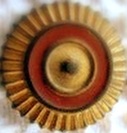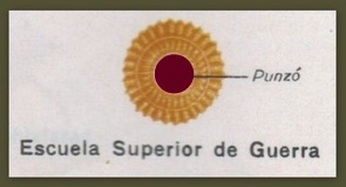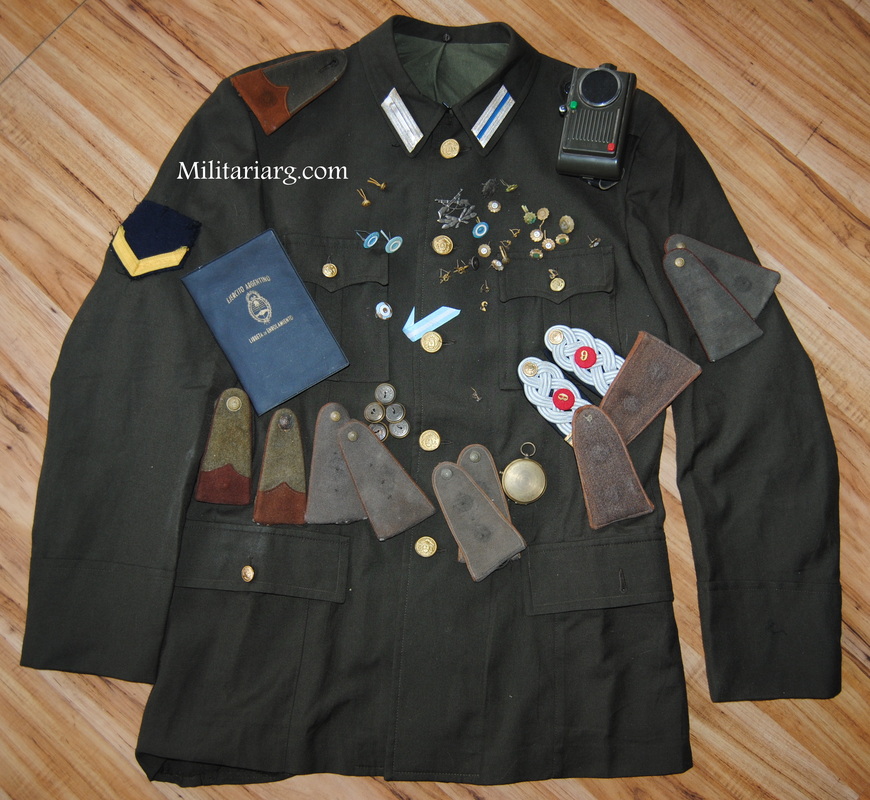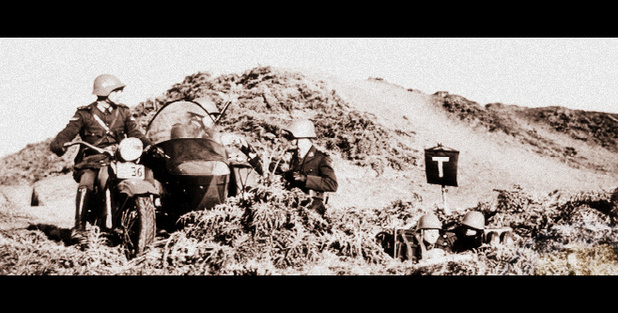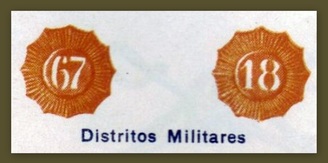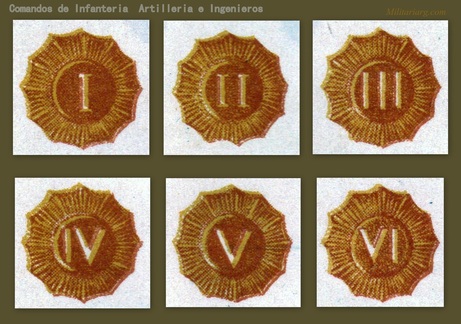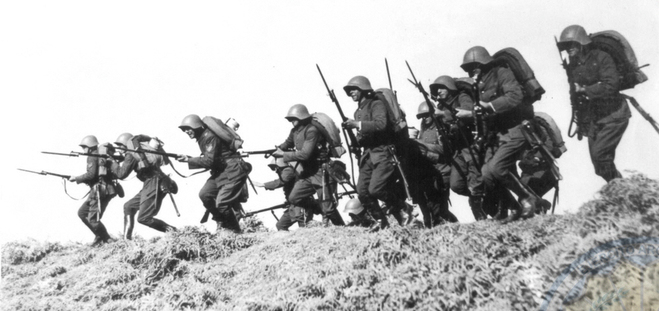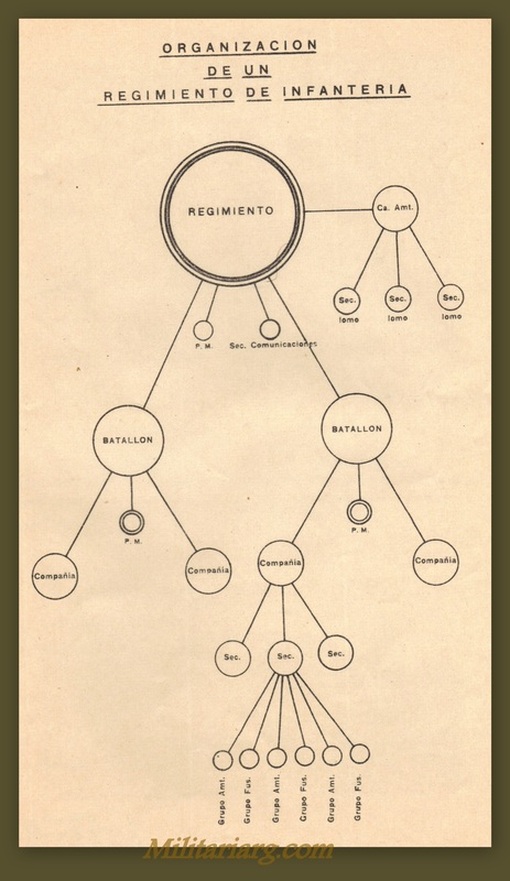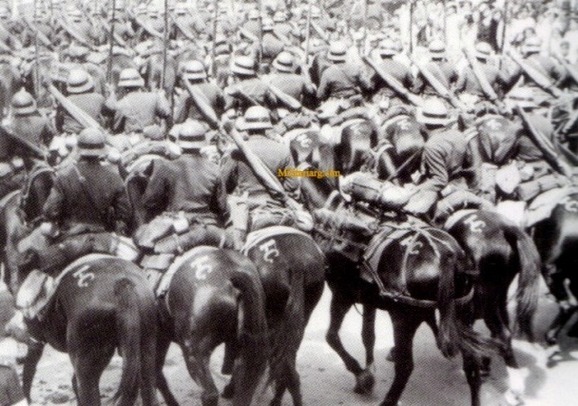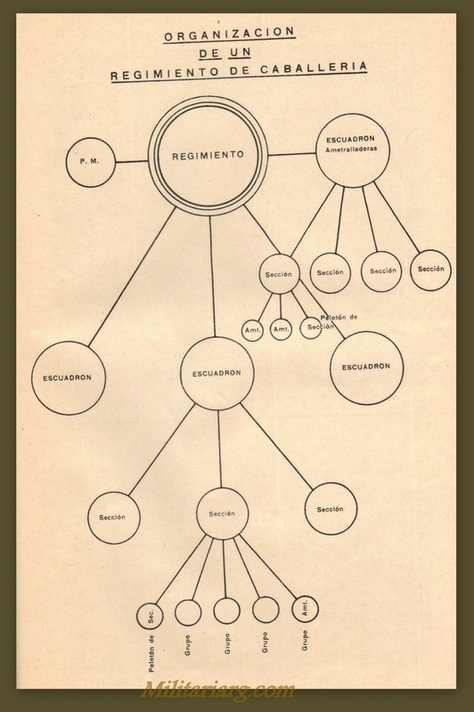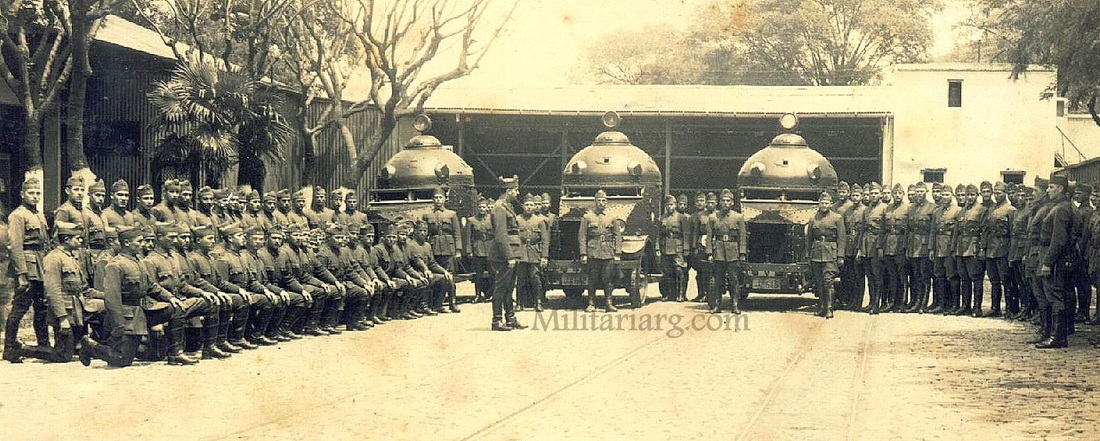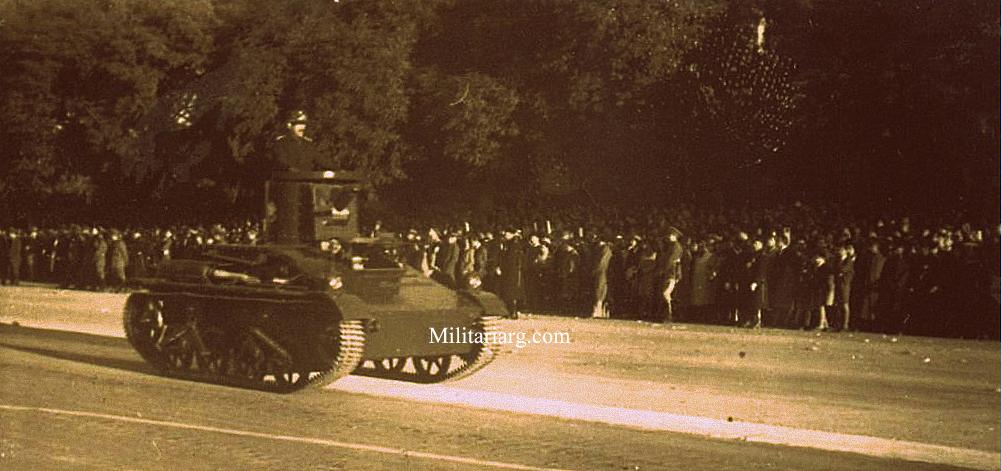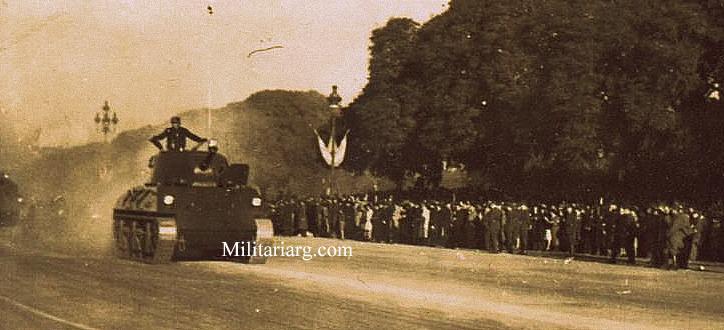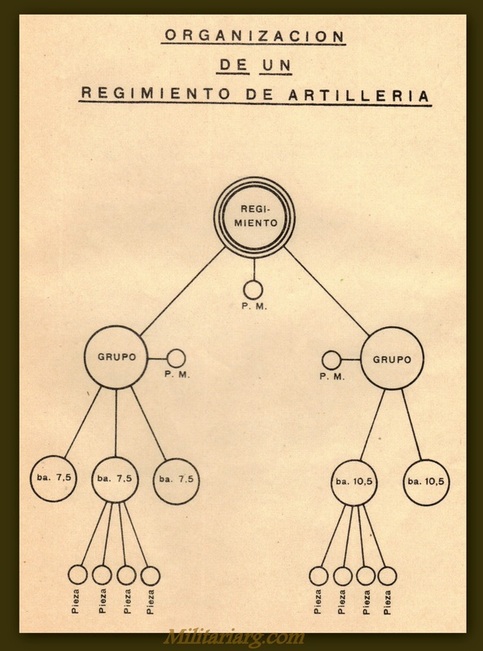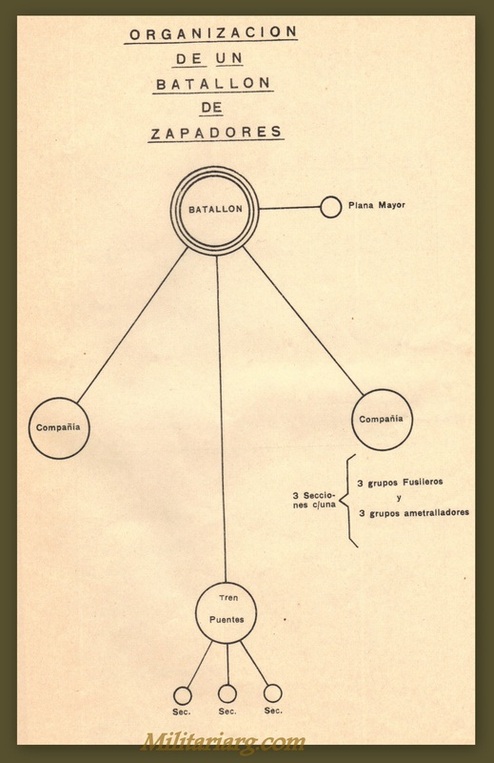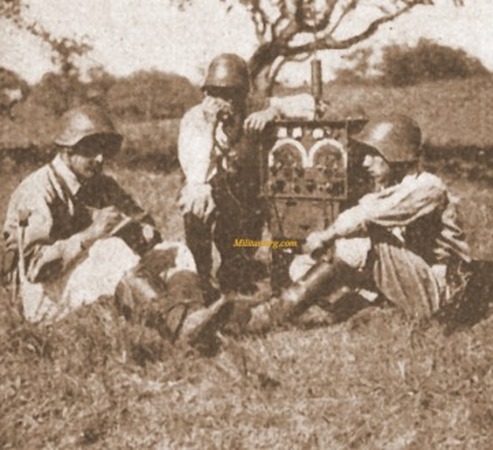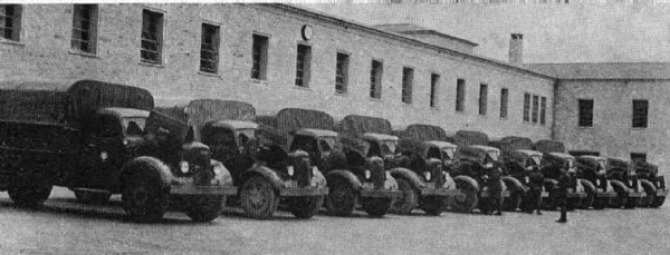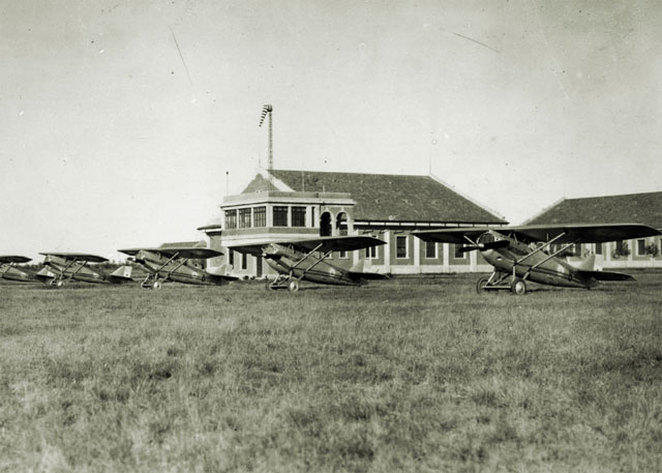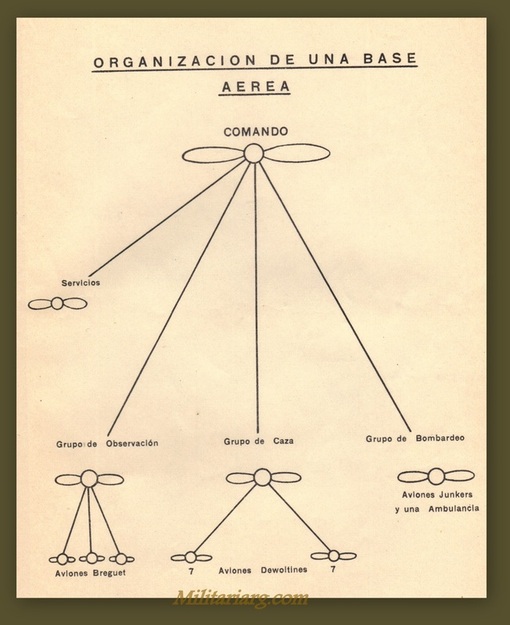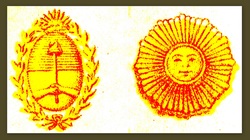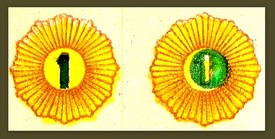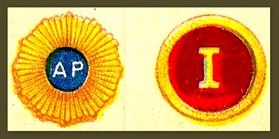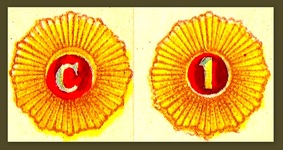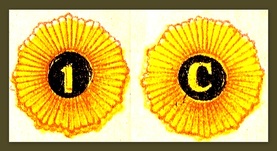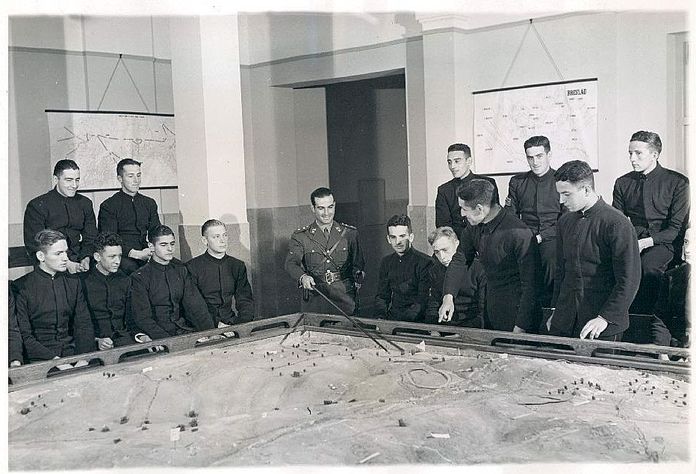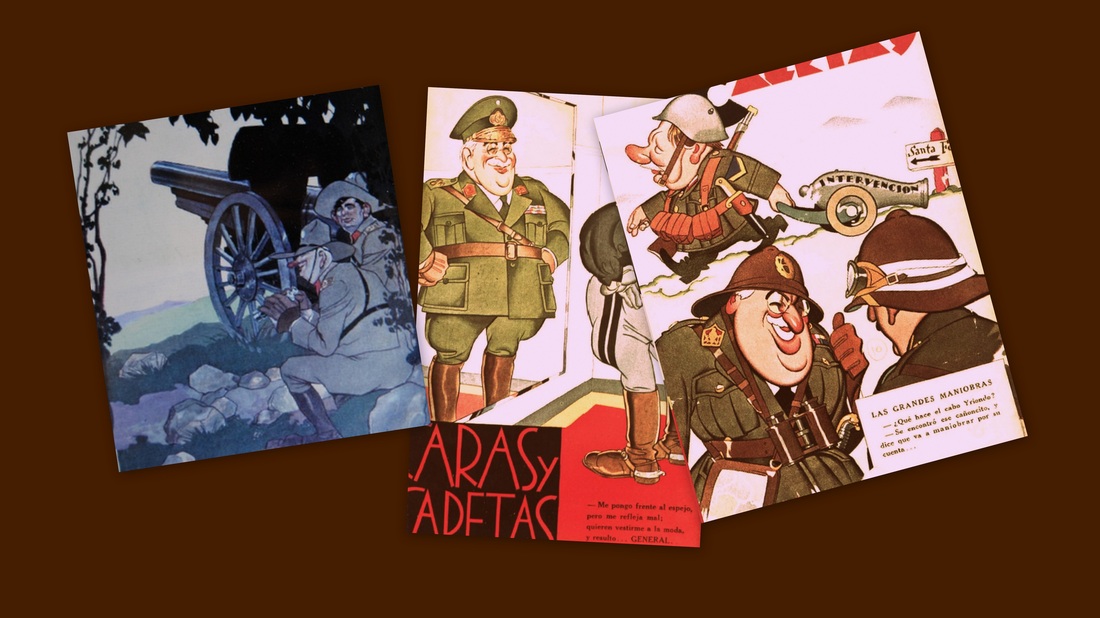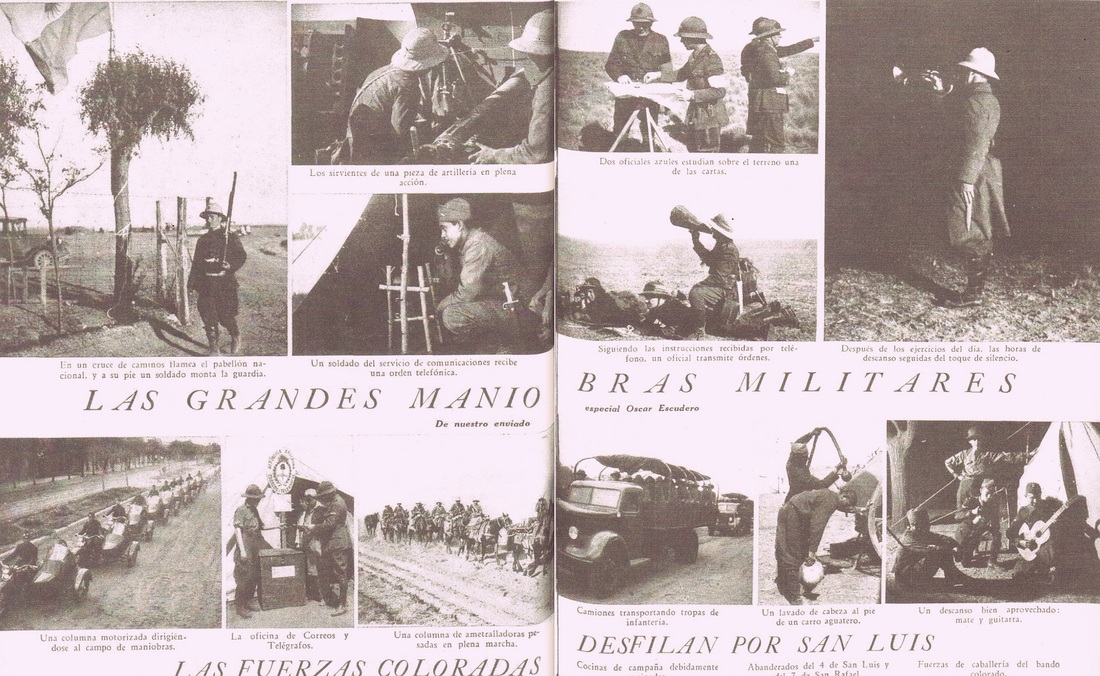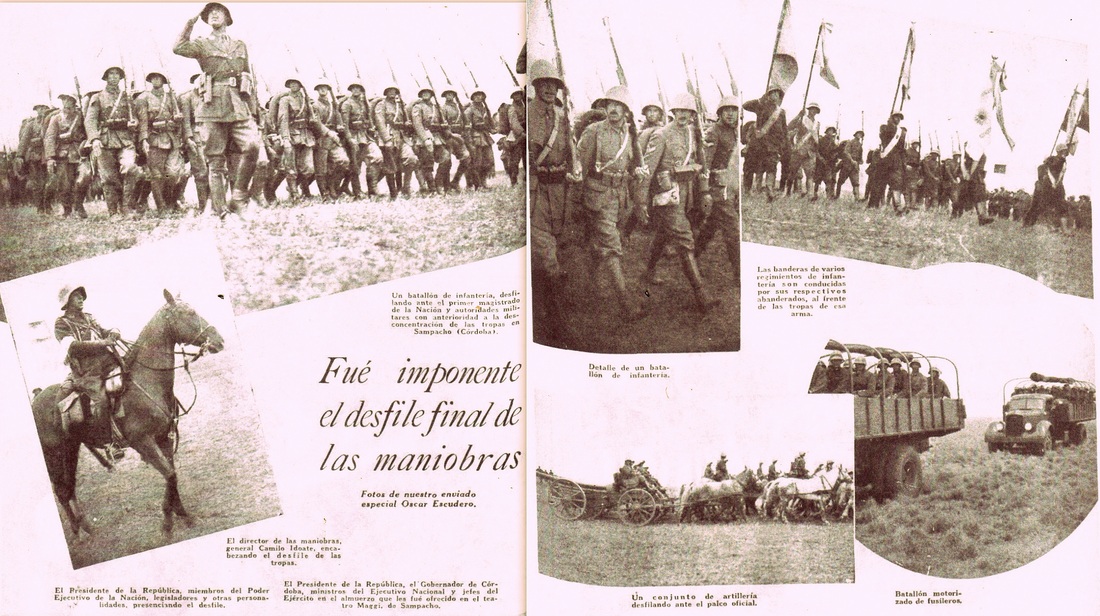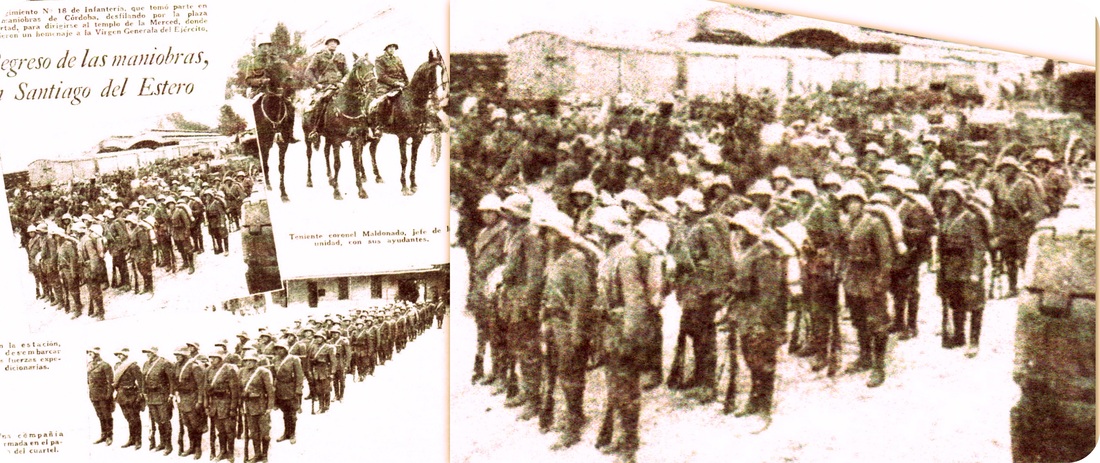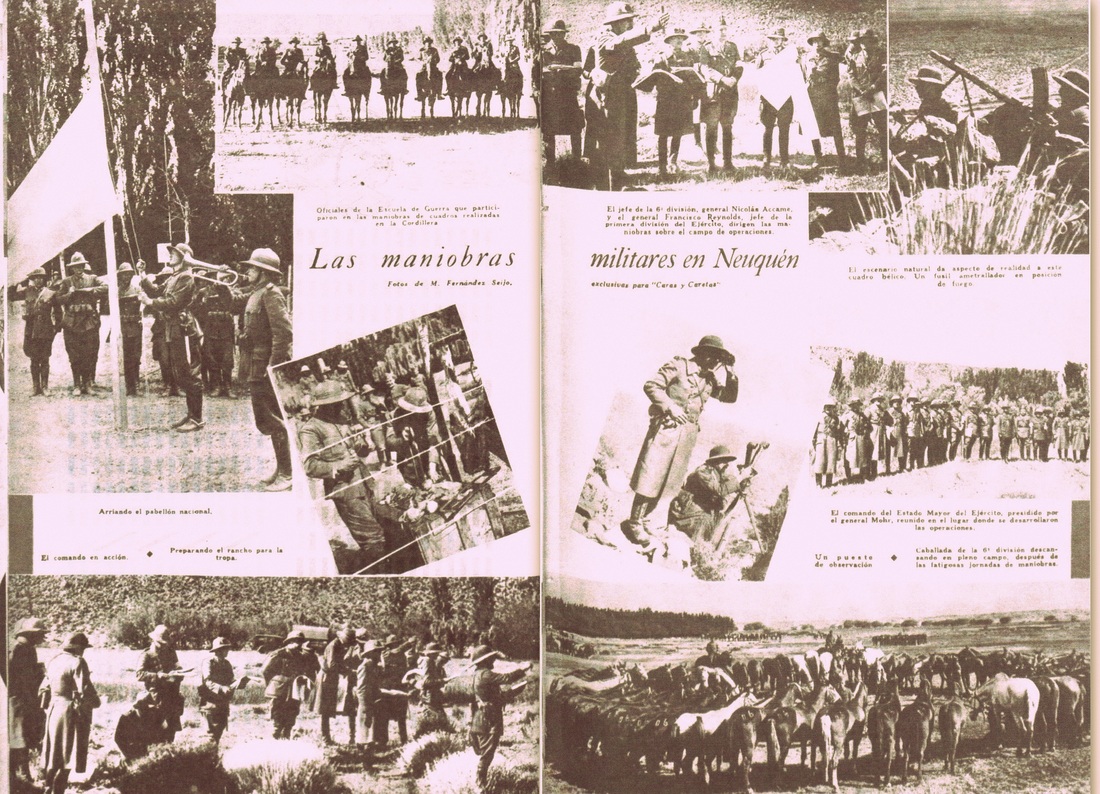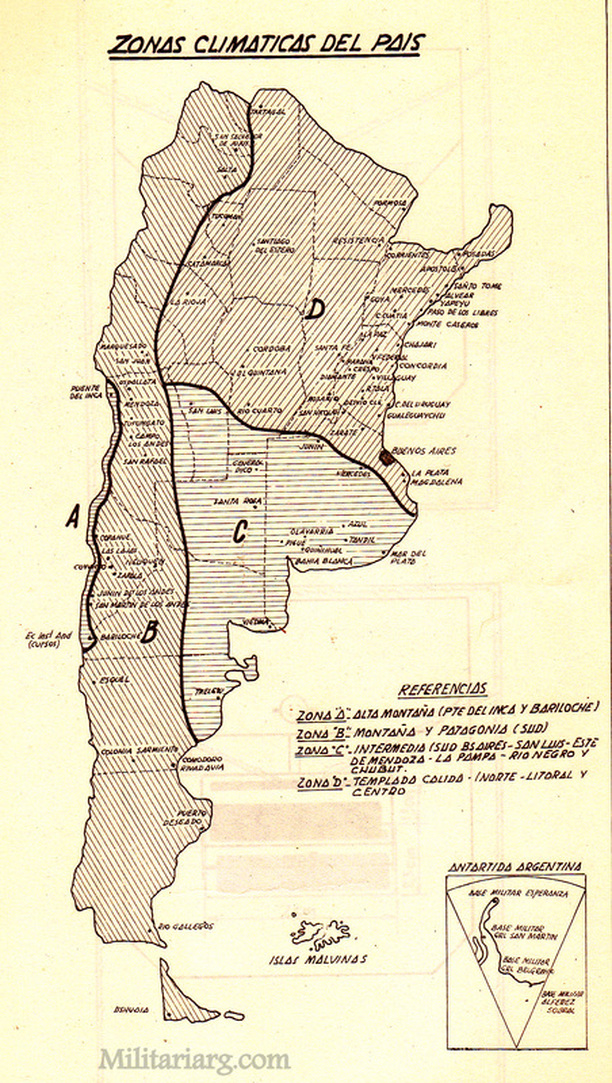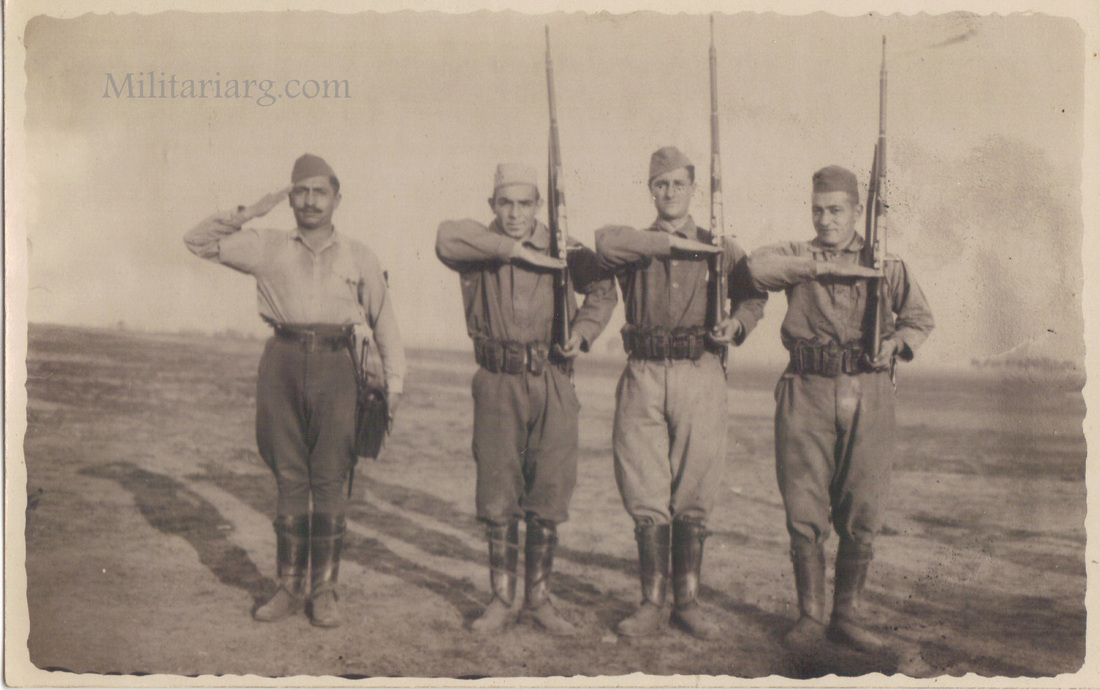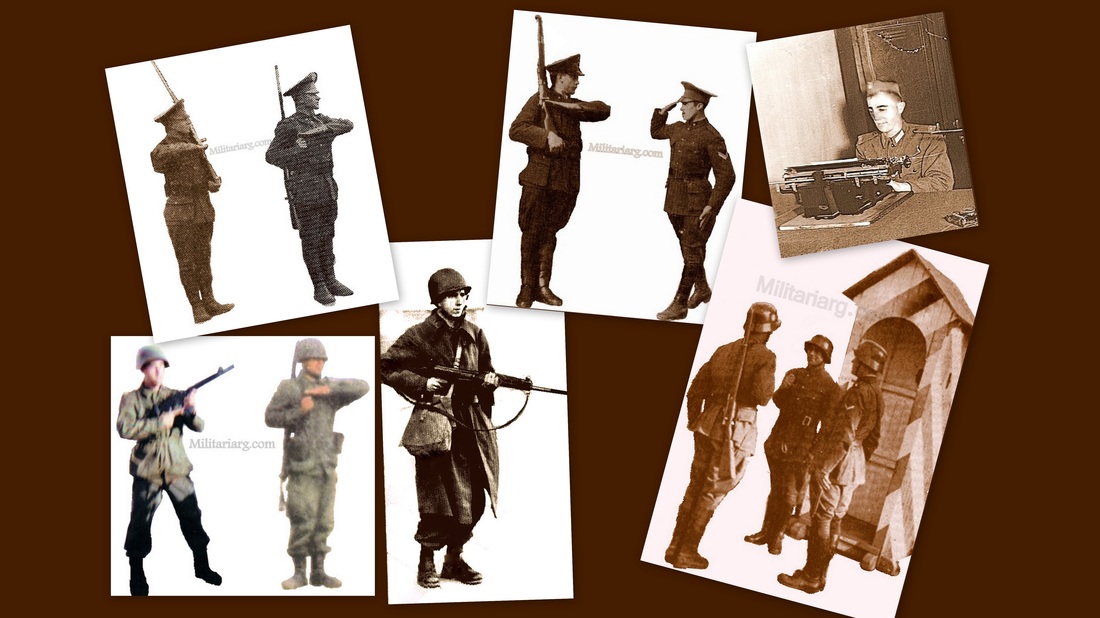Period 1900/30
February 29 1900. The War College of the Argentine Army was created. Until then officials prepared for the roles of staff in European schools. The Ministry of
War is organized on this new basis and was formed by the following institutions:
Military Cabinet
Central Administration Office.
Estado Mayor Staff.
In 1901 the Minister of War, Pablo Ricchieri, ordered the purchase of
several acres of fields, which is now known as "Campo de Mayo" in Buenos Aires.
And Field of "Los Andes", in the Andes Mendoza. Also presented the Army
Organization Act # 4031 to Congress.
This Act established conscription for all Argentine men between 20 and 25
years, which would last six months.
Military forces were divided in:
Line Army.
Reserve (19-28 years)
National Guard (28-40
years)
Territorial Guard (40 and 45 years)
Units are created of various weapons and the conformation of an
organization in accordance with European guidelines.
The Republic was dividided in these Military Regions:
Region Capital (Command in Capital Federal)
Neuquen Region (Command in
Bahia Blanca)
Uruguay Region (Command in Concord)
Litoral Region (Command
in Rosario)
Cuyo Region (Command i Mendoza)
Centre Region (Command in
Cordoba)
Northern Region (Command in Salta)
National Territories as directly under the Ministry of War:
Formosa
Chaco
Chubut
Santa Cruz
Tierra del Fuego
The Horse Grenadiers Regiment that was inactive for
nearly 80 years was recreated. Application School Officers, with the mission to
monitor the instructional officers. It could be considered the predecessor of
the War College. He established the School of Application of Health for training
of military surgeons, veterinarians and pharmacists . Military Tailoring is
created within the army quartermaster. It also created the School of Application
for artillery officers and Cavalry School. All were based in Campo de Mayo.
Re-diagramming in 1905 of the military regions:
1st Buenos Aires
2nd Sur
3rd Litoral
4th Centro y Mendoza
5th Norte
4707 law was sanctioned (Incompatibility between military and political
function)
1907 Reorganization of the Army:
20 Infantry Battalions 3 companies each.
One infantry company with cash of
war.
9 Cavalry Regiment w/4 squads.
1 Battery of guns mixed (Mounted & Wheeled).
1 Section of artillery on foot.
1 Battalion of Railwaymen.
5 Railway Company.
Army Corps Organization (1910):
I (1st and 2nd Division)
III (4th and 5th Division)
As of July 15th the Regiment 1 "Horse Grenadiers" became the Presidential
Escort.
In 1911 the Army adopted the Model 1909 Mauser rifle as regulatory Infantry.
Cavalry and Engineers would do the same with this carbine.
1912 establishing the Military Aviation School and joined the Madsen Machine Gun Model 1911.
In 1915, each region had its brigade commands:
Brigade Command Military Region Ira: Seat in the Federal Capital
Brigade Command II Military Region:
III Infantry Brigade based in Mercedes (BsAs)
IV Infantry Brigade based in La Plata.
The command of the brigades of cavalry and engineers in Campo de Mayo
Commands Brigade of the Military Region III:
V Infantry Brigade in Corrientes (Capital)
VI Infantry Brigade in Sorrento
Brigade Caballeria in Concordia
Artillery Brigade in Diamante
Infantry Brigade in Parana
Commands Brigade of the Military Region IV:
VII Infantry Brigade in Rio Cuarto
VIII Infantry Brigade in San Luis
Caballeria Brigade in Mendoza.
Artillery Brigade and Ingenieros in Cordoba
Brigade Command Military Region V:
IX Infantry Brigade in Santiago del Estero (Capital)
X Infantry Brigade in Jujuy (Capital)
Cavalry and Artillery Brigades in Salta (Capital)
Engineer Brigade in San Miguel (Tucuman)
1916 The War Office was re-organized:
5 Commands Military Regions
Secretary of the Ministry
General Audit of War
Army General Inspection
Staff of the Army
DGs:
Staff
Material
Engineers
Administration
Health
Shooting and
Gymnastics
It adopts Colt .45 pistol.
In 1917 the Regiment of Mounted Grenadiers (Presidential Escort) left the First
Division of the Army and became jurisdiction of the Presidency of the Nation.
Also in 1917 he created the regiments of cavalry of line 10, 11 and 12. Two
squadrons of machine guns and a regiment of Gendarmerie that would be organized in Formosa. Constituted in six brigades of cavalry, two regiments each.
1918 Weapons Inspections Infantry, Cavalry, Artillery and Engineers were
created .
Aeonautic Service is created which is the origin of the future Army Aviation and the Air Force Argentina.
Esteban de Luca Stockpile Battalion is founded.
The 3rd company in the arsenal San Lorenzo (Pto Borghi)
The 4th company in the Arsenal Jose Maria Rojas (Holmberg).
In 1921, 10 corps of Gendarmerie were created for the safety of the inhabitants of the national territory. Orders would respond to the respective governors and every body would have:
1 Captain
2 Lieutenants
4 lieutenants
1 Sergeant
12 Sergeants
Second
36 Cabos
248 Gendarmes.
In 1922 he called the National Army the Argentine Army. The President Marcelo T. De Alvear appointed John B. Right as Minister of War.
Juan B Justo creates the Military House of the Presidency of the Nation.
In 1923 he created the post of Inspector General of the Army as highest
institutional hierarchy. This reports directly to the Minister of War and whose
functions would be the supervision of everything related to orders, instruction
and inspection and along with the Army General Staff concerning the preparation
for war. The First Inspector General was Major General Jose Felix Uriburu.
It created the Mountain Detachment Command based Cuyo Mendoza and Northern Command Detachment in Salta.
1924 the Direction of Remonta was created under the Ministry of War. Other
general inspections are created as cavalry, artillery and sappers and
communications subordinate to the Inspector General of the Army.
It creates the School of Communications based on transmissions troops.
General Justo (Minister of War), major command military maneuvers across the
country, a fact that resulted in numerous infrastructure, bridges, buildings,
etc..
It creates the January 26, 1924 Military Aviation School, separating group I
Obverbacion.
In the Palomar Communications Battalions 1 and 2 was created and in Cordoba the Military Aircraft Factory. Also the Direction General of Aeronautics in Mendoza was the base of Observation Group 4.
Military hospitals:
Campo de Mayo
Parana
Cordoba
Tucuman
In 1929 he created the Palomar Air Base where grouped Military Aviation School
and groups:
N1 Observation
Hunting N1
Bombing N1
Source:
Period 1936/38
Between 1936 and 1938 the Argentine Army was organized regionally into six divisions with dependent units and subunits, 68 military districts for recruiting classes all over the country.
Only 16 of such centers in Buenos Aires and the rest took into account the increased population density areas. 9 institutes of training for officers and NCO's centralized in Buenos Aires.
Only 16 of such centers in Buenos Aires and the rest took into account the increased population density areas. 9 institutes of training for officers and NCO's centralized in Buenos Aires.
Photo from the National Archives of Argentina
1st Division (Federal Capital), was composed of an infantry and artillery command in a military complex located in the City of Buenos Aires over an administrative department.
The 2nd Division (Campo de Mayo) and an infantry and artillery command based in Campo de Mayo with an administrative department and a health department.
The 3rd Division in Parana Entre Rios with an infantry and artillery command, an administrative department and a health department.
4th Division (Cordoba), with an infantry and artillery command, an administrative department and a health department.
The 5th Division (Salta), also with an infantry and artillery command, plus an administrative service.
(6th Division (Patagonia), Inf Reg 8 "Comodoro Rivadavia" and Inf Reg 5 "Bahia Blanca).
All this regionalization is further complemented by two Mountain commands, one called Detachment Cuyo in Mendoza and Mountain Detachment "North" in Salta. A command of Federal Capital Military Aircraft.
All of this deployment is complemented by other smaller units and the battalion of Railwaymen in Campo de Mayo, in addition to large departments, special units and isolated formations.
Take into account that major units could be mobilized in joint maneuvers in Buenos Aires:
Division 1 (Federal Capital) would frame the Infantry Regiments 1 "Patrician", 2 and 3. Mounted Grenadiers Regiment and based in Reg 8 Liniers / Citadel (Ciudadela) Artillery Regiment 1 in Liniers / Citadel. The Division 2 (Campo de Mayo), encuadraria Infantry Regiments to 4 and 10. Cavalry Regiment 2 and 10. Artillery Regiment 2 and 6 but the group of horse artillery and railway transport units.
All this could also have counted on the reinforcement of the 6th Infantry Reg Mercedes and Bahia Blanca Reg 5 and groups 1 Engineers (San Nicolas), dependent on the 2 Division (Campo de Mayo).
In case of a national emergency calling for a general mobilization, the permanent army circumvented classes of 20 Years old. The Permanent Army Reserve were made up of citizens from 21 to 30. National Guard for citizens 30 to 40. Territorial Guard for 40 to 45 Years old.
All this could also have counted on the reinforcement of the 6th Infantry Reg Mercedes and Bahia Blanca Reg 5 and groups 1 Engineers (San Nicolas), dependent on the 2 Division (Campo de Mayo).
In case of a national emergency calling for a general mobilization, the permanent army circumvented classes of 20 Years old. The Permanent Army Reserve were made up of citizens from 21 to 30. National Guard for citizens 30 to 40. Territorial Guard for 40 to 45 Years old.
All these forces should be presented to the military districts of their towns or areas. The logistical and material equipment described in Army documents were outdated (practically from the First World War) as well as their tactics and doctrines.
It was not until 1936 that the individual endowment of the steel hull was taken seriously into account, a vital element of protection which was established during the Great War.
The scarcity of transport upped the importance of sea transport and rail transport, even so this means could not solve the Transfer of large units anywhere in the country, and it is a means for the time would serve as logistic Transfer tactical means to be highly vulnerable from the air and the sabotage of their ways.
Even so the territorial disproportion in relation to the population to almost half that south of the country was without military precencia be practically deserted, only one unit (Reg 8), Comodoro Rivadavia thousands of miles away from the metropolis covered the territorial extension that covered the five military divisions, two of them located in Buenos Aires.
Patagonia for Homeland time was considered, according to documents from the time, described at Reg 8 (Comodoro Rivadavia) and military districts from Bahia Blanca (Reg 5), Santa Roza Pampa, Viedma, Trelew Neuquen and a "6 Division" .
In military jargon, it was popular to say that as punishment for a soldier it would send to the south and it is no coincidence as the Patagonian territories were considered a kind of desert climate and difficult terrain, certainly in proportion to the unpopulated northern half the country where the major centers.
It was not until 1936 that the individual endowment of the steel hull was taken seriously into account, a vital element of protection which was established during the Great War.
The scarcity of transport upped the importance of sea transport and rail transport, even so this means could not solve the Transfer of large units anywhere in the country, and it is a means for the time would serve as logistic Transfer tactical means to be highly vulnerable from the air and the sabotage of their ways.
Even so the territorial disproportion in relation to the population to almost half that south of the country was without military precencia be practically deserted, only one unit (Reg 8), Comodoro Rivadavia thousands of miles away from the metropolis covered the territorial extension that covered the five military divisions, two of them located in Buenos Aires.
Patagonia for Homeland time was considered, according to documents from the time, described at Reg 8 (Comodoro Rivadavia) and military districts from Bahia Blanca (Reg 5), Santa Roza Pampa, Viedma, Trelew Neuquen and a "6 Division" .
In military jargon, it was popular to say that as punishment for a soldier it would send to the south and it is no coincidence as the Patagonian territories were considered a kind of desert climate and difficult terrain, certainly in proportion to the unpopulated northern half the country where the major centers.
Regiment of infantry units by:
Reg 1 (Capital Federal)
Reg 2 (Capital Federal)
Reg 3 (Capital Federal)
Reg 4 (Campo de Mayo Buenos Aires)
Reg 5 (Bahia Blanca Buenos Aires)
Reg 6 (Mercedes province of Buenos Aires)
Reg 7 (La Plata province of Buenos Aires)
Reg 8 (Comodoro Rivadavia Chubut Province)
Reg 9 (Corrientes Province)
Reg 10 (Campo de Mayo Aires province)
Reg 11 (Rosario Santa Fe)
Reg 12 (Santa Fe province of Santa Fe)
Reg 13 (Cordoba province of Cordoba)
Reg 14 (Rio Cuarto Cordoba province)
Reg 15 (San Juan Province San Juan)
Reg 2nd Battalion of the 15 was in the province of La Rioja)
Reg 16 (Mendoza province of Mendoza)
Reg 17 (Catamarca Province Catamarca)
Reg 18 (Santiago del Estero)
Reg 19 (Tucuman province of Tucuman)
Reg 20 (Jujuy province of Jujuy)
(Infantry regiments were organized into two battalions with two companies of three sections each. Each section had three groups and three machine-gun rifle. Each regiment also had a machine gun company, theoretically mounted, mounted in three sections, plus a communications section and a Military Police. Anios It was not until the 50s where heavy foot marches were driven.
Cavalry Regiments:
Regiment "Grenadiers Riding, General San Martin" (Capital Federal)
Reg 1 (Campos Los Andes Province of Mendoza)
Reg 2 (Campo de Mayo Buenos Aires)
Reg 3 (Gualeguay province of Entre Rios)
Reg 4 (Villa Mercedes San Luis Province)
Reg 5 (Salta province of Salta)
Reg 6 (Concordia Entre Rios)
Reg 7 (National Table Mendoza)
Reg 8 (Liniers / Ciudadela Buenos Aires)
Reg 9 (Curuzu Cuatia Corrientes)
Reg 10 (Campo de Mayo Buenos Aires)
Reg 11 (Paso de los Libres Corrientes)
(Each Cavalry Regiment consisted of three squadrons of three sections each, each section had five groups, one of amatralladoras. In turn, the Cavalry Regiment had a unique machine-gun squad with four sections of three groups each. Also each regiment had a section of military police and other specialties). While the cavalry had become obsolete by mid-twentieth century, the Argentine Army used it in exploration tasks and liaison. The cavalry was used as the spearhead of the formations and the security service during the marches. The army still depended on the blood drive for the transfer of artillery and logistics, would not be until 1950 when the motorization additional full membership. From the 50, the horse is beginning to be mechanized.
Artillery Regiments:
Reg 1 (Liniers / Ciudadela Buenos Aires)
Reg 2 (Campo de Mayo Buenos Aires)
Reg 3 (Diamante Province of Entre Rios)
Reg 4 (Cordoba province of Cordoba)
Reg 5 (Salta province of Salta)
Reg 6 (Campo de Mayo Buenos Aires)
Artillery Group 1 Mountain (Mendoza province of Mendoza)
Group 2 Mountain Gunner (Salta province of Salta)
Group 2 Horse Artillery (Campo de Mayo Buenos Aires)
Group 3 Horse Artillery (Goya Corrientes)
Group 4 Horse Artillery (San Luis San Luis Province)
(Each Artillery Regiment was composed of two groups. One group had three batteries of 75mm 7.5cm with four pieces each. A group of two batteries of 105mm 10.5cm with four pieces each). Almost all of the field and heavy artillery was pushed by horses and chariots exception of anti-aircraft units that were partially motorized.
Reg 1 (Liniers / Ciudadela Buenos Aires)
Reg 2 (Campo de Mayo Buenos Aires)
Reg 3 (Diamante Province of Entre Rios)
Reg 4 (Cordoba province of Cordoba)
Reg 5 (Salta province of Salta)
Reg 6 (Campo de Mayo Buenos Aires)
Artillery Group 1 Mountain (Mendoza province of Mendoza)
Group 2 Mountain Gunner (Salta province of Salta)
Group 2 Horse Artillery (Campo de Mayo Buenos Aires)
Group 3 Horse Artillery (Goya Corrientes)
Group 4 Horse Artillery (San Luis San Luis Province)
(Each Artillery Regiment was composed of two groups. One group had three batteries of 75mm 7.5cm with four pieces each. A group of two batteries of 105mm 10.5cm with four pieces each). Almost all of the field and heavy artillery was pushed by horses and chariots exception of anti-aircraft units that were partially motorized.
Pontoneros Sapper units (Engineers):
Agrupacion 1 (San Nicolas Buenos Aires)
Agrupacion 2 (Concepcion del Uruguay Entre Rios)
Battalion 3 (Parana Entre Rios)
(Each battalion of sappers had a staff of engineers, two companies, as well as the infantry had three sections each with three rifle and three groups of machine guns. A pontoon company with three sections of Engineers).
Communications:
Battalion 2 (El Palomar Buenos Aires)
Battalion 3 (Parana Entre Rios)
Battalion 4 (Cordoba)
Battalion 5 (Tucuman)
FWD Trucks
Arsenals
Arsenal Esteban de Luca "(Capital Federal)
Arsenal "San Lorenzo" (Puerto Borghi province of Santa Fe)
Arsenal "Jose Maria Rojas" (Holmberg province of Cordoba)
Stockpile Battalion "Wells" (Capital Federal)
(From Arsenal Esteban de Luca "depended scarce Vickers light tanks and other armored British manufacturing)
Arsenal Esteban de Luca "(Capital Federal)
Arsenal "San Lorenzo" (Puerto Borghi province of Santa Fe)
Arsenal "Jose Maria Rojas" (Holmberg province of Cordoba)
Stockpile Battalion "Wells" (Capital Federal)
(From Arsenal Esteban de Luca "depended scarce Vickers light tanks and other armored British manufacturing)
Dewoitine D.21
Air Bases:
Base Aerea "El Palomar" (Buenos Aires)
Base Aerea "Urquiza (Parana Entre Rios)
Base Aerea "The Tamarind (Province of Mendoza)
Aerotecnica address and Military Aircraft Factory (Cordoba).
(Each Air Force Base was formed by a Central Command, a group with three aircraft Breguet obserbacion. A group of seven aircraft Dewoitine hunting each. A group of Junkers aircraft bombing, an ambulance. Also had a mechanical services group .)
Sources: Military records 1938. Regulation of Driving and Combat (R.R.M.35).
Casa Militar del Presidente de la Nacion y Secretaria del Consejo de Defensa Nacional. Right: Comando de Ejercito. Comandos de Division de Ejercito, (Sus Comandos de Armas, Destacamentos de Exploracion y Servicios de Retaguardia).
Left: Comando de la Agrupacion "Patagonia", (Unidades de Zapadores, Comunicaciones y sus Servicios de Retaguardia).
Right: Comando de Brigada de Caballeria.
Right: Comando de Brigada de Caballeria.
C: Comando de Caballeria de Ejercito. 1: Comando de Division de Caballeria, (Columnas de Abastecimiento, Unidades de Zapadores Pontoneros y Comunicaciones de la Division Caballeria.
Right: Comando de Destacamento de Montaña, )Sec Exp, Baqueanos, Unidades de Zapadores, Comunicaciones y Columnas de Abastecimientos Dependientes.
Right: Comando de Destacamento de Montaña, )Sec Exp, Baqueanos, Unidades de Zapadores, Comunicaciones y Columnas de Abastecimientos Dependientes.
Source: R.U Uniform Regulation 1946.
Photo: UPI/AP
Caras y Caretas 1936.
Caras y Caretas 1936.
Caras y Caretas 1937.
